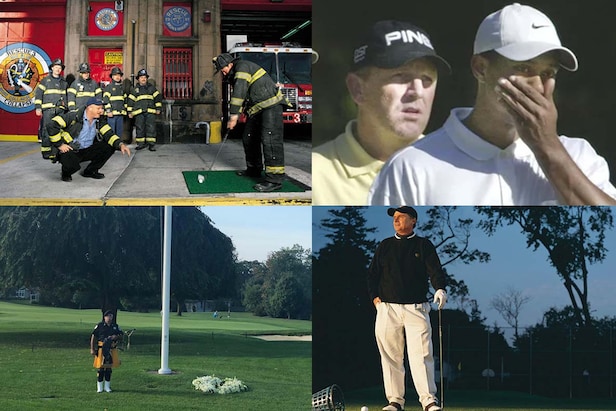There is not a segment of American society that wasn’t touched by the events of Sept. 11, 2001, and golf’s connection runs deep. From the many golfers who perished on 9/11, to the way the game ground to a halt both at the professional and club level, to the shift in priorities many golfers cite following that day, it is a solemn anniversary at a time of year when, cruelly, the golf weather in much of the country is often close to ideal.
At Golf Digest, we’ve written a number of memorable golf 9/11 stories. On this 20th anniversary, here are a few worth revisiting.
Jimmy Dunne’s story is equal parts heartbreaking and inspiring. Out of the office on 9/11 because he was playing a U.S. Mid-Am qualifier, he learned mid-round that many of his closest friends and colleagues at his firm, Sandler O’Neill, were on the 104th-floor office of the South Tower that morning. In the months and years since, Dunne committed himself to keeping Sandler O’Neill alive, caring for the families of the 66 victims in the firm who died, while still remaining devoted to the game he learned as a caddie on Long Island. The 2002 story by Tim Rosaforte and Bill Fields, which ran in Golf Digest’s sister publication, Golf World, was honored as a top feature story by the Golf Writers Association of America.
Very little about Tiger Woods’ incredible career has been underreported, but the vast impact of his foundation might be an exception. Although Woods and his father Earl launched the foundation shortly after Tiger turned pro in 1996, Woods has said it was the events of 9/11 that inspired him to double down on his efforts to help others. Joel Beall writes about the long drive Woods took home after that week’s World Golf Championship in St. Louis was canceled, and how it helped him arrive at one of the most important decisions of his career.
In a curious bit of timing, the first U.S. Open played after 9/11 was at Long Island’s Bethpage Black. The first true municipal course to host a major is also located outside New York City and often frequented by the first responders who were among the hardest hit by the attacks. As part of Golf Digest’s June 2002 U.S. Open preview, Dave Kindred wrote about the many golf-loving firefighters whose lives were irrevocably altered that September day.
The significance of this anniversary has never been lost on me. In addition to losing a good friend, I was at the time a newspaper reporter based in suburban New York who wrote a series of stories about the victims, their families, and their many connections to the sports world. For years, I’ve struggled with the simple question of whether it’s right to even play golf on such a somber day. This essay weighs both sides of the argument.
Among those New York places where 9/11 strikes a deep chord is Winged Foot Golf Club. Four of the club’s members were killed in the attacks, and those who survived were left to mourn them and dozens of other family, friends and colleagues. In the days and weeks following 9/11, Winged Foot members said the golf course became a refuge—which it became again at the outset of the COVID-19 pandemic. Ahead of the 2020 U.S. Open at Winged Foot, which fittingly was postponed from June to mid-September, I talked to people at the club about the similarities between the two crises, and the important role golf played in both.
